Nam Dinh - the land in the south of Red River Delta, the hometown of Tran Dynasty, illustrious Dong A spirit - "the country is always stable and prosperous for eternity". This province plays an important role during the ups and downs of Vietnam history. This is the land of culture, birthplace of many principal graduates, "khoi nguyen", and intellectuals who bring the fame to the country, a unique cultural area mixed between the sea culture and delta culture, scholarly culture and folklore. The land of southern Red River Delta is making great contribution to the changing process of the country. Nam Dinh is a large province with 2 million population located in the south of North Delta. As planned in 2008, Nam Dinh belonged to the Red River Delta.
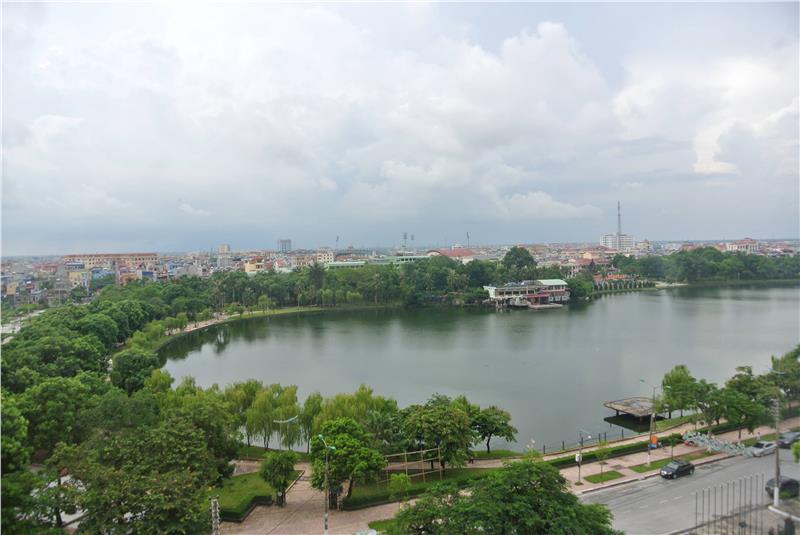
Lying in the south of Red River Delta, Nam Dinh is situated between 19°54′ to 20°40′ north latitude, 105°55′ to 106°45′ east longtitude. Nam Dinh shares border with Thai Binh in the North, Ninh Binh in the South, Ha Nam in the Northwest and the Gulf of Tonkin in the East. Nam Dinh has the natural area of 1652.29km2 (accounting for 0.5% of the national area), is divided into 10 administrative units including Nam Dinh city and 9 districts.
Nam Dinh terrain is relatively flat, mainly low-lying plains and coastal delta. The northwest of province concentrates a few low hills as Bao Dai, Ngo Xa (or so-called Thuong Son, Mai Son - Y Yen), Coi Son (or Goi Mountain), Non Coi, Ho Son, Kim Bang (Kim Thai today), Trang Nghiem (Ngam Mountain)... Coi Mountain and Vi River are the famous scenic spots of Nam Dinh. Nam Dinh has 72-kilometer long coastline from Ba Lat estuary to Day estuary, some places has fine sandy beaches suitable with tourism development.
Nam Dinh weather brings full characteristics of the tropical monsoon climate. The average temperature is 23°C - 24°C. The average humidity is 80 - 85%. Total days of sunshine are 250 days. The total number of sunshine hours is 1650-1700 hours. The average rainfall reaches 1750 - 1800mm. The rainy season runs from May to October, while the dry season starts in November and February next year. On the other hand, because of situating in the Gulf of Tonkin, every year, Nam Dinh is often affected by storms or tropical depression on the average of 4-6 storms/ year (about from July and October).
Nam Dinh is the land located between downstreams of two big rivers of Read River Delta including Red River and Day River. The flow of Red River and Day River combined with the diurnal tide has formed 2 large alluvial grounds along coast including Con Lu, Con Ngan (Giao Thuy) and Con Troi, Con Mo (Nghia Hung). In addition to two large rivers, there are tributaries of the Red River flowing into Day River or sea. From North to South, Dao River is chosen as the boundary of 2 regions of north and south, Ninh Co river flows into Lac estuary (Got Chang), So river (Ngo Dong river) flows into Ha Lan estuary.

In Nam Dinh, the traces of ancient people in this period remain in mountain ranges of Vu Ban and Y Yen districts. Here, archaeologists found stones axes, stone pestle and grinding table. It is the remains of the inhabitants of the Neolithic period or Bronze period from mountainous region down to the coastal region to live and settle villages. At the zenith of the Neolithic period, Nam Dinh as well as many places in the country flourished the primitive cultures. In addition to gathering the available products in nature, ancient people in Nam Dinh started agricultural production, livestock and poultry.
During the period of Hung Kings, Nam Dinh consisted of districts: Vu Ban, Y Yen, My Loc, Nam Dinh city and the north of Nam Truc district today. After Nam Viet was invaded by Tay Han Dynasty in 111 BC, the country stepped into the Chinese domination lasting over 1000 years. At that time, Nam Dinh was located in Giao Chi district. Due to the favorable conditions for wet rice cultivation, Nam Dinh early became an agricultural center. After Ngo Quyen death, the Red River basin was dominated by Tran Lam lord. Nam Dinh took place fiercely battles of heroes around the country.
Under Ly, Tran Dynasty, Nam Dinh was not onlt a gateway to Red River Delta but also an important economic center of the country. Kings Ly spent special attention to this land. Kings Ly had built at least 2 palaces as the stopovers in Nam Dinh when visiting here. Under Le Dynasty, Nam Dinh belonged to Son Nam; until the second year of Canh Hung in 1741, this land belonged to Son Nam Ha. During the reign of Nguyen Dynasty, in 1822 (the 3rd of Minh Mang), Son Nam Ha renamed Nam Dinh.
Until the 13th year of Minh Mang (1832), Nam Dinh tran was changed into Nam Dinh province with 4 palaces, 18 districts including the parts of Thai Binh today. In 1890, Thai Binh was split into a separate province. Nam Dinh remained 2 palaces and 9 districts. After August Revolution, 1945, administrative units of Nam Dinh often had the change. Until now, Nam Dinh province has 10 administrative units including 1 city and 9 districts.
According to the population census in 2010, Nam Dinh has 2,005,771 people with the population density of 1,196 people/ km2. Kinh ethnic group covers the majority population of Nam Dinh, so Vietnamese is used commonly in this province. Nam Dinh people follow 2 major religions, namely Buddhism and Christianity.
Nam Dinh province has 1 city and 9 districts including Nam Dinh city, Giao Thuy district, Hai Hau district, My Loc district, Nam Truc district, Nghia Hung district, Truc Ninh district, Vu Ban district, Xuan Truong district, Y Yen district.
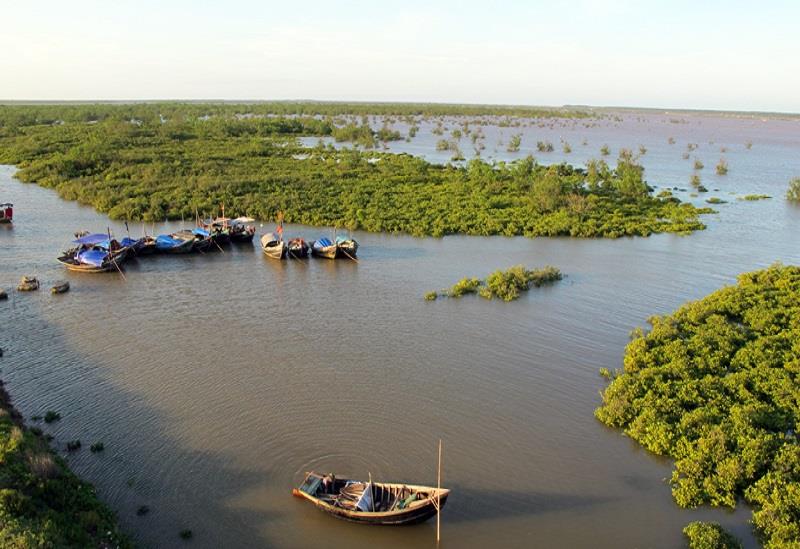
Nam Dinh is one of the populous cities in the country and the important resource for socio-economic development. Nam Dinh lies in the key agricultural region of North Delta. Simultaneously, Nam Dinh has developed the industrial production relatively early with many traditional industries and is one of the leading textile center of the country.
Nam Dinh economy in 2014 achieved significant results. Agricultural production reached the comprehensive result in 2 crops, in which seasonal crop was one of the most successful crops for many years, livestock and fisheries were fulfilled. The total production value of agriculture, forestry and fishery was estimated at 4.1% compared to 2013. Gross regional domestic product GRDP (at constant price 1994) was estimated at 16,007 billion dong, up 12.5% over the 2013, GRDP per capita (current price) reached 30 million dong.
The province's agricultural production grew pretty, especially textile, footwear, mechanics for agricultural production, construction, pharmaceutical products, so on. The total value of industrial production (at constant price 1994) was estimated at 22,212 billion dong, up 22.5% compared to 2013. Trade activities have positive signs. Total retail sales of goods and service reached 23,536 billion dong, an increase of 15.4% over 2013.
Education and training: Continue to hold the position as one of the top provinces of educational movement and quality of education in the country.
Health: Implement solutions to improve the quality of health care service for people, beneficiaries of social welfare and people with health insurance. Highly concentrate for monitoring, and prevention diseases.
Labor – Society: Create jobs for 31 thousand labor (including 1950 labor exports).
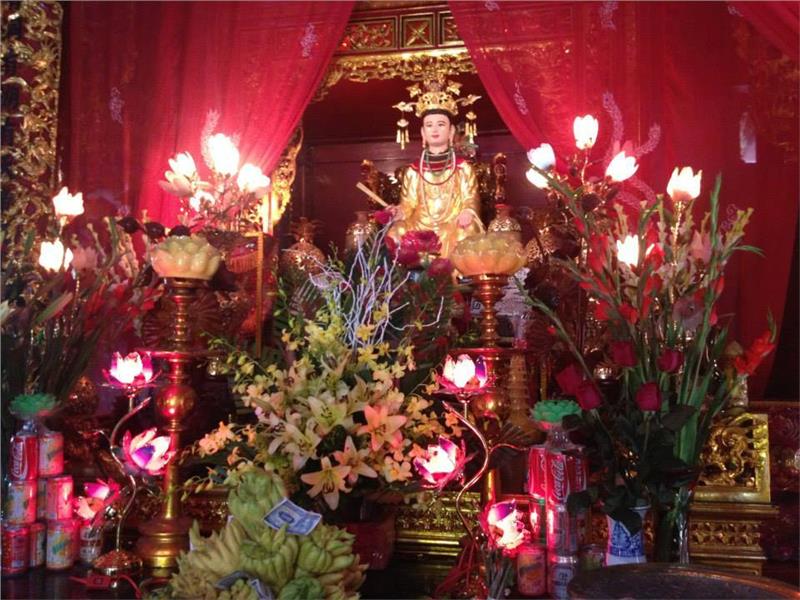
Nam Dinh is the place where Tran Dynasty started the career (13th - 14th century) and the birthplace of many celebrities, martial generals whose names and their career have been recorded in the history and who people worship like Quoc Cong Tiet Che Hung Dao Dai Vuong Tran Quoc Tuan. Nam Dinh is the land of traditional fondness for learning with schools established since Le dynasty in Nang Tinh village. In the academic feudalism, Nam Dinh had 5 principle graduates, 3 "bang nhan", 3 "tham hoa", 14 "hoang giap", 62 doctors and "pho bang", typically Nguyen Hien, Luong The Vinh, Dao Su Tich, Vu Tuan Chieu, Tran Van Bao, Tran Bich San.
In addition, Nam Dinh is a typical and unique cultural land with typical characteristics of the land of "giao thuy". Eating, dressing, staying and traveling of Nam Dinh people is the adaption and harmony between human and nature, the utilization and exploitation of human to the natural environment along the river and the sea. Due to the folk belief, custom of worshiping ancestors, Tutelary God, the northern region of Nam Dinh is seen as a scared space that starts and has become the religious center of worshiping Holy Mother Lieu and Saint Tran. The coastal region of Nam Dinh is the first place received Christianity and has become the center of Christian. Confucianism, Taoism, Buddhism, Christianity and other religions exist and develop parallel, even they are harmonized in every village, every family, making religious life and belief of Nam Dinh more outstanding, rich and unique.
Shortly, Nam Dinh is a land rich in tradition of patriotism, revolution and creative work, a typical economic and cultural area and has an important position throughout the Vietnam history.
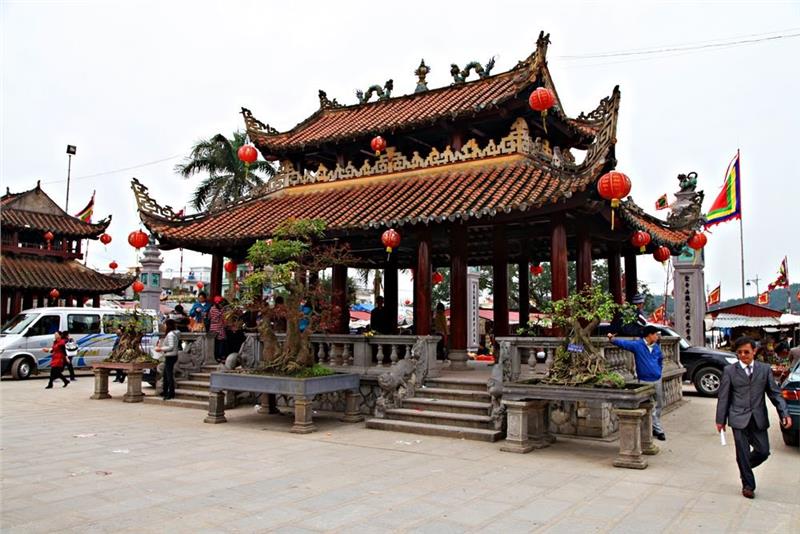
Nam Dinh is a coastal province located about 90km far from Hanoi. Thanks to social-economic conditions and favorable resources, Nam Dinh tourism has potentials to develop with high and sustainable speed. The system of road, railway and waterway connects localities and regions in the country, especially the trans-Vietnam railway and National Route No.10. In addition, the Red River route connecting Hanoi with Nam Dinh and other southern provinces of North Delta is contributing to the diversification of tourism products.
In Nam Dinh province, there are 1.655 historical - cultural relics, of which 268 have been rated including 74 national relics and 194 provincial relics. Many relics have historical, cultural and architectural value associated with traditional festivals appealing domestic and foreign tourists such as Tran cultural relic population, Phu Day, Co Le pagida, Keo Hanh Thien pagoda, the memorial house Late General Secretary Truong Chinh.
In addition, Nam Dinh has more than 70 traditional villages and traditional products. Many villages are known around the country such as La Xuyen, Cat Dang, Tong Xa, Vinh Hao, Co Chat, Vi Khe, etc.
Being one of the provinces forming the cradle of wet rice civilization in Red River Delta, Nam Dinh is known for the unique intangible culture associated with the working life of local people. Traveling Nam Dinh, tourists cannot miss cheo melodies, sweet van singing. Interestingly, tourists can drop by water puppetry troupe to see artisans performing in Thuy Dinhor can see the performance of fishermen in Nghia Hung, Hai Hau on 4-5-meter-hight stilts.
Nam Dinh has 72-km long coastline with beaches exploited and built into attractive beach resort as Thinh Long (Hai Hau ditrict), Quat Lam (Giao Thuy). Especially, estuarine wetland where Red River flows into the South China Sea with ecosystems of mangroves is the home to migratory birds and the first international Ramsar in Vietnam and Southeast Asia (1989), until early 2003, it was recognized as Xuan Thuy National Park by Prime Minister. In 2005, it was recognized the Biosphere Reserve in Red River Delta.
The plain, well-off countryside, customs and habits, cultural activities featuring Red River wet rice civilization is suitable for tourism type "exploring countryside". Tourists can comfortably sit on tile covered bridge across the river built for centuries ago according to the architecture "thuong gia - ha tri" (house above, river behind). From here, you can contemplate endless paddy fields, banian tree, ancient communal house and listen to the bell vibrating after the bamboo trees.
Coming to Nam Dinh is coming to the special culinary culture with dishes and delicacies making the brand of Nam Dinh as Pho Soup, banh cuon in Kenh village, gai cake Ba Thi, peanut candy Siu Chau, "nem nam" Giao Thuy, Xuan Dai rice, etc.
Festival
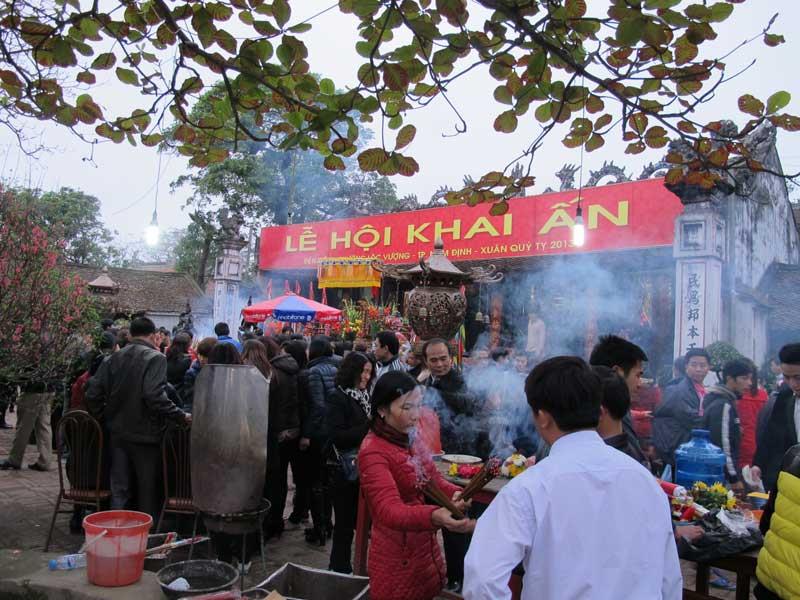
Nam Dinh province has many festivals mostly village festival, but some festivals have their own identities and high specificity. Especially, these festivals bear purely Vietnamese religious style. That is the belief of worshiping Holy Mother, typically Phu Day cultural-historical relic population (Kim Thai commune, Vu Ban district) and worshiping Saint Tran (Saint Tran Hung Dao). These are two large and famous festivals in Nam Dinh.
Phu Day - the special relic, the largest religious center worshiping Holy Mother in Vietnam. Right from the first days of spring, Cho Vieng (Vieng Market) attracts thousands of people from different localities. In particular, the official festival in Phu Day holds in the 3rd lunar month to commemorate the death anniversary of Holy Mother. Phu Day festival is a large festival in Vietnam and is the leading center of Holy Mother Belief.
In addition, Holy Father festival in Nam Dinh is held in the death anniversary of Saint Tran Hung Dao - a talented General, a National Hero who contributed significantly to the Tran Dynasty career, and worshiped widely in temples and the spiritual life of Vietnamese people in general and Nam Dinh people in particular. Nam Dinh is the hometown of Tran Dynasty with the system of palaces, temples, towers, and tombs.
In the first days of spring, in the hometown of Tran Dynasty, many cultural activities is taken place, especially "le khai an" (proclamation worshiping) held in night of 14th January, this ritual attracts many people around the country. In particular, in 8th lunar month every year, Tran temple festival is held with rituals: palanquin procession, cheo singing, van singing, bai bong dance, sword dance, and wrestling. Tran cluster monuments along with Tran festival are the historic lines nurturing the patriotic tradition. It also contains the national strength taking us further steps in the renewal process of the country. It has contributed to enriching the national cultural identity and unique features of Nam Dinh festivals today and in the past as well.
As one of the cradle of Red River Delta civilization, the center of Red River Delta Vietnam, festivals in Nam Dinh not only satisfy the spiritual need of people but also bring the characteristics of region. In addition the general features, Nam Dinh festival brings its own cultural feature associated with the geographic, economic, cultural and social features or characters worshiped in relics. Festivals always exist and develop from the actual development of society and need of spiritual life of people, the belief in the protection of of the supernatural power.
